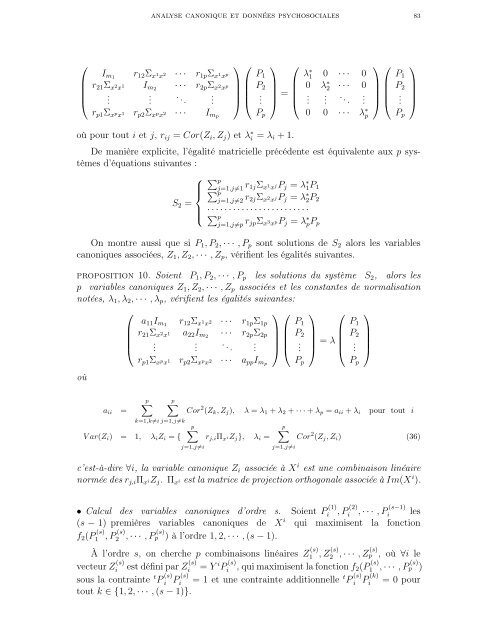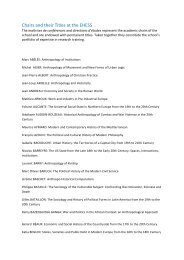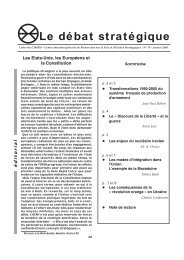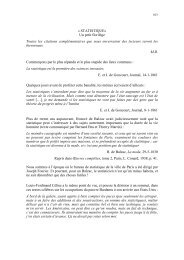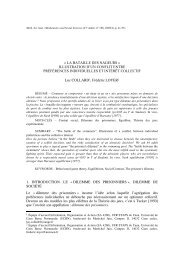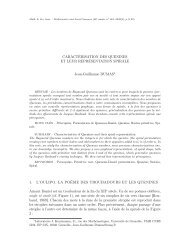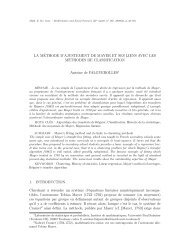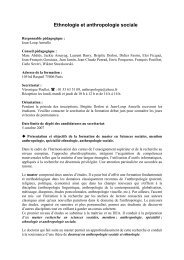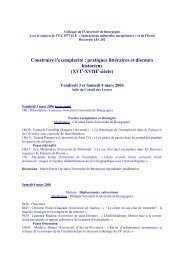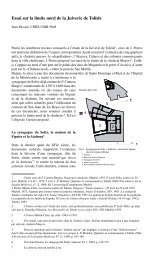LES ANALYSES CANONIQUES SIMPLE ET GÉNÉRALISÉE ...
LES ANALYSES CANONIQUES SIMPLE ET GÉNÉRALISÉE ...
LES ANALYSES CANONIQUES SIMPLE ET GÉNÉRALISÉE ...
You also want an ePaper? Increase the reach of your titles
YUMPU automatically turns print PDFs into web optimized ePapers that Google loves.
⎛<br />
⎜<br />
⎝<br />
analyse canonique et données psychosociales 83<br />
Im1 r12Σx1x2 · · · r1pΣx1xp r21Σx2x1 Im2 · · · r2pΣx2xp .<br />
.<br />
. ..<br />
rp1Σ x p x 1 rp2Σ x p x 2 · · · Imp<br />
.<br />
⎞ ⎛<br />
⎟ ⎜<br />
⎟ ⎜<br />
⎟ ⎜<br />
⎠ ⎝<br />
où pour tout i et j, rij = Cor(Zi, Zj) et λ ∗ i = λi + 1.<br />
P1<br />
P2<br />
.<br />
Pp<br />
⎞<br />
⎛<br />
λ∗ 1 0 · · · 0<br />
0 λ∗ 2 · · · 0<br />
⎞ ⎛<br />
⎟<br />
⎠ =<br />
⎜<br />
⎝ . .<br />
. .. .<br />
0 0 · · · λ∗ ⎟ ⎜<br />
⎟ ⎜<br />
⎟ ⎜<br />
⎠ ⎝<br />
p<br />
De manière explicite, l’égalité matricielle précédente est équivalente aux p systèmes<br />
d’équations suivantes :<br />
S2 =<br />
⎧<br />
⎪⎨<br />
⎪⎩<br />
p<br />
j=1,j=1 r1jΣ x 1 x jPj = λ ∗ 1P1<br />
p<br />
j=1,j=2 r2jΣ x 2 x jPj = λ ∗ 2P2<br />
· · · · · · · · · · · · · · · · · · · · · · · ·<br />
p<br />
j=1,j=p rjpΣ x 3 x pPj = λ ∗ pPp<br />
On montre aussi que si P1, P2, · · · , Pp sont solutions de S2 alors les variables<br />
canoniques associées, Z1, Z2, · · · , Zp, vérifient les égalités suivantes.<br />
proposition 10. Soient P1, P2, · · · , Pp les solutions du système S2, alors les<br />
p variables canoniques Z1, Z2, · · · , Zp associées et les constantes de normalisation<br />
notées, λ1, λ2, · · · , λp, vérifient les égalités suivantes:<br />
⎛<br />
a11Im1<br />
⎜ r21Σx2x1 ⎜<br />
⎝ .<br />
r12Σx1x2 a22Im2<br />
.<br />
· · ·<br />
· · ·<br />
. ..<br />
⎞ ⎛ ⎞ ⎛ ⎞<br />
r1pΣ1p P1 P1<br />
r2pΣ2p<br />
⎟ ⎜<br />
⎟ ⎜ P2<br />
⎟ ⎜<br />
⎟ ⎜ P2<br />
⎟<br />
⎟ ⎜ ⎟ = λ ⎜ ⎟<br />
. ⎠ ⎝ . ⎠ ⎝ . ⎠<br />
où<br />
aii =<br />
rp1Σ x p x 1 rp2Σ x p x 2 · · · appImp<br />
p<br />
p<br />
k=1,k=i j=1,j=k<br />
V ar(Zi) = 1, λiZi = {<br />
Pp<br />
Cor 2 (Zk, Zj), λ = λ1 + λ2 + · · · + λp = aii + λi pour tout i<br />
p<br />
j=1,j=i<br />
rj,iΠ x iZj}, λi =<br />
p<br />
j=1,j=i<br />
Pp<br />
P1<br />
P2<br />
.<br />
Pp<br />
⎞<br />
⎟<br />
⎠<br />
Cor 2 (Zj, Zi) (36)<br />
c’est-à-dire ∀i, la variable canonique Zi associée à X i est une combinaison linéaire<br />
normée des rj,iΠ x iZj. Π x i est la matrice de projection orthogonale associée à Im(X i ).<br />
• Calcul des variables canoniques d’ordre s. Soient P (1)<br />
i , P (2)<br />
i , · · · , P (s−1)<br />
(s − 1) premières variables canoniques de X<br />
i les<br />
i qui maximisent la fonction<br />
f2(P (s)<br />
1 , P (s)<br />
2 , · · · , P (s)<br />
p ) à l’ordre 1, 2, · · · , (s − 1).<br />
À l’ordre s, on cherche p combinaisons linéaires Z (s)<br />
1 , Z (s)<br />
2 , · · · , Z (s)<br />
p , où ∀i le<br />
vecteur Z (s)<br />
i est défini par Z (s)<br />
i<br />
sous la contrainte t P (s)<br />
i<br />
P (s)<br />
i<br />
tout k ∈ {1, 2, · · · , (s − 1)}.<br />
= Y i P (s)<br />
i , qui maximisent la fonction f2(P (s)<br />
1 , · · · , P (s)<br />
p )<br />
= 1 et une contrainte additionnelle t P (s)<br />
i<br />
(k)<br />
P i<br />
= 0 pour


